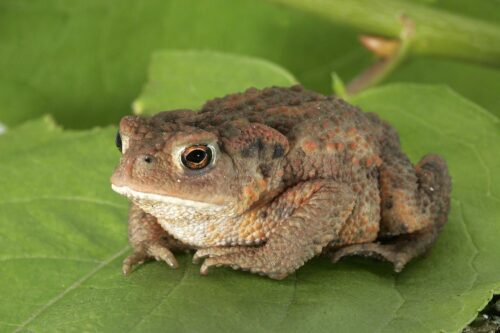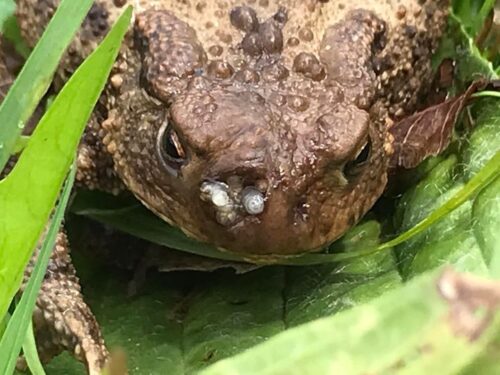The common toad belongs to the family of true toads and, with its plump shape, is a familiar sight in almost all of Europe.
Also known as:
European toad
This common toad is a victim of the toadfly (Lucilia bufonivora). This fly prefers to lay its eggs in the nostrils of the toad. After the eggs hatch, the larvae eat away parts of the nose, then nestle in the nasal cavity to feed on the eyes, brain and other soft tissues. Eventually, the toad dies a grim death.
Common toad (Bufo bufo) is a frog belonging to the family of true toads (Bufonidae). The common toad, with its plump shape, is a familiar sight throughout Europe – except in Ireland and Iceland.
The common toad grows to about 11 cm in size in temperate regions; in warmer countries they can grow to over 15 cm. The common toad has orange-yellow eyes with a horizontal, slit-shaped pupil. The toad has a brown (sometimes dark, sometimes light) skin, covered with warts. The belly is greyand marbled. The male is a few cm smaller than the female. In captivity, a toad can live to be about 35 years old – in the wild (disease, birds of prey, traffic) a lot less: 10 to 12 years.
The common toad lives on insects, snails and slugs, spiders, ants and earthworms. The common toad also eats young birds that have fallen from the nest, mice and snails.
Birds (heron, buzzard, tawny owl) prey on toads.
The common toad is found in vegetated, somewhat moist environments (grasslands, roadsides, forest edges, bogs). During the day they hide in shady places under rocks, shrubs and leaf piles.
For reproduction (fresh) water is needed: preferably still water with lots of underwater vegetation in which the female deposits the eggs in long transparent strings. The common toad lays her eggs in the water where they were born. This means that toads head for their native waters in droves in early spring. This is the toad migration, in which there are many traffic casualties among the toads.
Where to find
- Commonly found
Control
The common toad eats insects, snails, and larvae; do not remove any that may be found.
Prevention
Does not apply.


